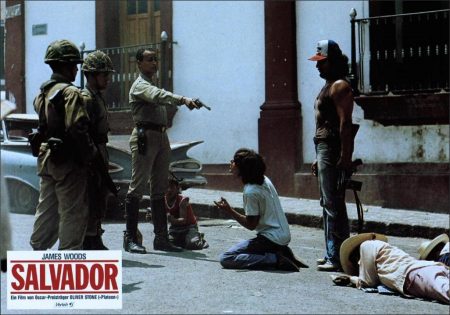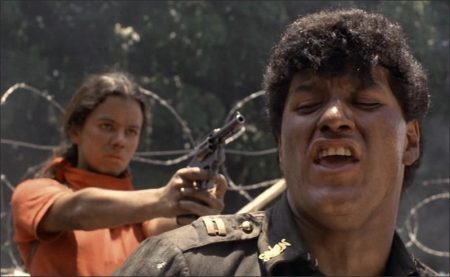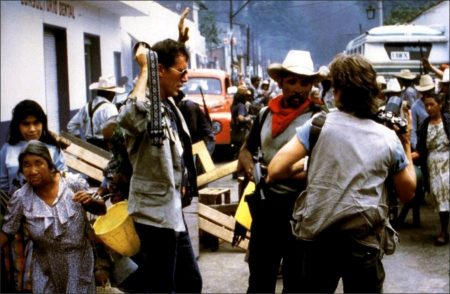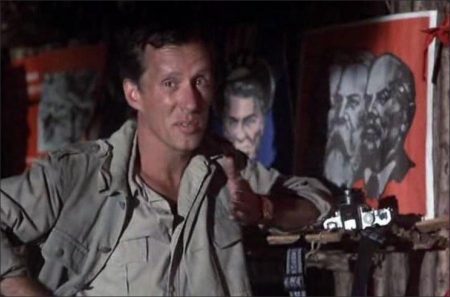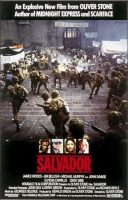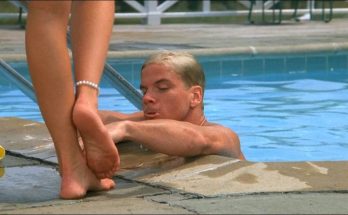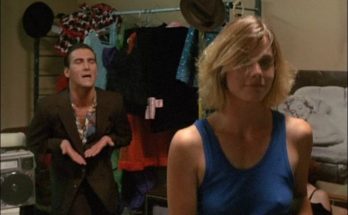Salvador movie storyline. A journalist, down on his luck in the US, drives to El Salvador to chronicle the events of the 1980 military dictatorship, including the assasination of Archbishop Oscar Romero. He forms an uneasy alliance with both guerillas in the countryside who want him to get pictures out to the US press, and the right-wing military, who want him to bring them photographs of the rebels. Meanwhile he has to find a way of protecting his Salvadorean girlfriend and getting her out of the country.
Salvador is a 1986 American war drama film co-written and directed by Oliver Stone. Stone wrote the screenplay with Richard Boyle. It stars James Woods as Richard Boyle, alongside Jim Belushi, Michael Murphy and Elpidia Carrillo, with John Savage, and Cynthia Gibb in supporting roles.
The film tells the story of an American ex-IPN journalist and one-time author of the 1972 book The Flower of the Dragon: The Breakdown of the U.S. Army in Vietnam, covering the Salvadoran Civil War who becomes entangled with both leftist guerrillas and the right wing military while trying to rescue his native girlfriend and her children.
The film is highly sympathetic towards the left wing revolutionaries and strongly critical of the U.S.-supported military, focusing on the murder of four American churchwomen, including Jean Donovan, and the assassination of Archbishop Óscar Romero by a death squad. The film was nominated for two Academy Awards: Best Actor in a Leading Role (Woods) and Best Writing, Screenplay Written Directly for the Screen (Stone and Boyle).
Film Review: Salvador
El Salvador descended into a brutal civil war between 1980 and 1992, pitting leftwing guerrillas against a rightwing military administration. Notoriously, the United States involved itself, fearing that a leftwing victory would advance the spread of communism. Washington aided the rightwing army, which carried out a horrific programme of repression, torture, disappearances and massacres. More than 30,000 people disappeared by the regime were still unaccounted for at the end of the war.
The film follows the alleged adventures of real-life gonzo photojournalist Richard Boyle (James Woods). It’s 1980, and Boyle is desperate to cover the emerging conflict. The problem is, he’s not so much a few sandwiches short of a picnic as also lacking the coleslaw, the strawberries, the swiss rolls, the fizz, a hamper and a blanket. With his equally eccentric DJ sidekick, Dr Rock (James Belushi), Boyle decides to drive to central America from San Francisco, the two of them consuming the greatest possible quantities of tequila, pills and prostitution along the way. At this point, it’s as if a much less amiable version of Withnail & I had gone on holiday by mistake again, only to El Salvador rather than Penrith. Unfortunately, in this film, things are about to get a lot less funny.
Politics
The up-and-coming warlord is Major Max, a thinly-veiled version of the real Roberto D’Aubuisson. D’Aubuisson was an army major assigned to the Salvadoran Special Services. After the coup in October 1979 he left the army, taking intelligence files and officers with him, to set up a network of death squads.
The scene in which Major Max is shown railing against Archbishop Óscar Romero in front of a roomful of henchmen, almost directly quoting Henry II in asking who will rid him of this turbulent priest, looks too theatrical to be true. However, some reports do suggest that D’Aubuisson held a similar meeting, at which his aides drew lots for the “honour” of assassinating Romero.
Violence
The real assassination of Romero was dramatic enough, though Stone embellishes it, having Romero’s shooter taking communion from the archbishop rather than hiding behind a pillar. Boyle is shown, entirely inaccurately, sitting a few seats away. The film gets into problematic territory as it places Boyle at the centre of more and more real events in which, at best, he was really on the distant periphery.
These include the guerrilla battle at Santa Ana, the rape and murder of four American churchwomen by a death squad, and the tribulations faced by US ambassador Robert E White (again, thinly veiled by a fictional name), who is caught between the malevolent intentions of the CIA and the humanitarian crisis before him.
The cartoonish excesses of Stone’s characters add to the pervading sense of fiction – heroic yet flawed journalists, spoilt blonde TV broadcasters, corrupt and greasy Salvadoran thugs, noble guerrillas, and strong-jawed American Reaganites with such manifestly evil intentions you could be forgiven for expecting them to operate from a volcanic lair with a fluffy white cat on their laps. Quite a lot of the things Stone shows are accurate, but you wouldn’t know it to watch this film.
The film reaches a peak of untruth with the fates of photojournalist John Cassady, and Boyle’s girlfriend Maria. As the film ends, title cards tell you what happened afterwards to Boyle and to the murderers of Romero. They also tell you that Cassady’s photos were published, and that Maria ended up in a refugee camp.
The difference is that Boyle and Romero really did exist, but Cassady did not; and that the scene wherein Boyle tries to sneak Maria into the United States is fictional. It’s actually irresponsible to mislead the audience in this way. If Stone is prepared to muddle up fact and fiction so blatantly, why should you believe any of this?
Verdict
Events in El Salvador were as bad as, and worse than, this film shows, but playing fast and loose with reality doesn’t make the case.
Salvador (1986)
Directed by: Oliver Stone
Starring: James Woods, Jim Belushi, Michael Murphy, John Savage, Elpidia Carrillo, Tony Plana, Colby Chester, Cynthia Gibb, Valerie Wildman, Salvador Sánchez, Rosario Zúñiga
Screenplay by: Oliver Stone, Richard Boyle
Production Design by: Bruno Rubeo
Cinematography by: Robert Richardson
Film Editing by: Claire Simpson
Costume Design by: Kathryn Morrison
Music by: Georges Delerue
Distributed by: Hemdale Film Corporation
Release Date: February 28, 1986
Visits: 234
